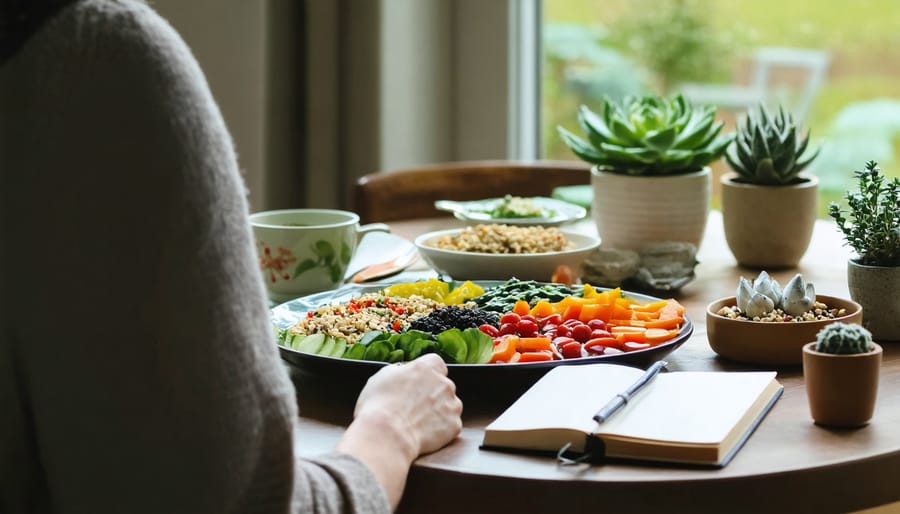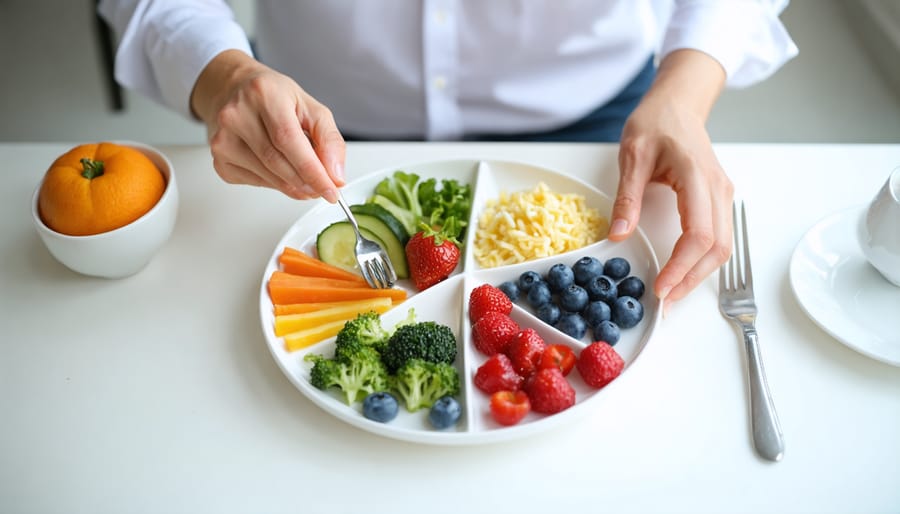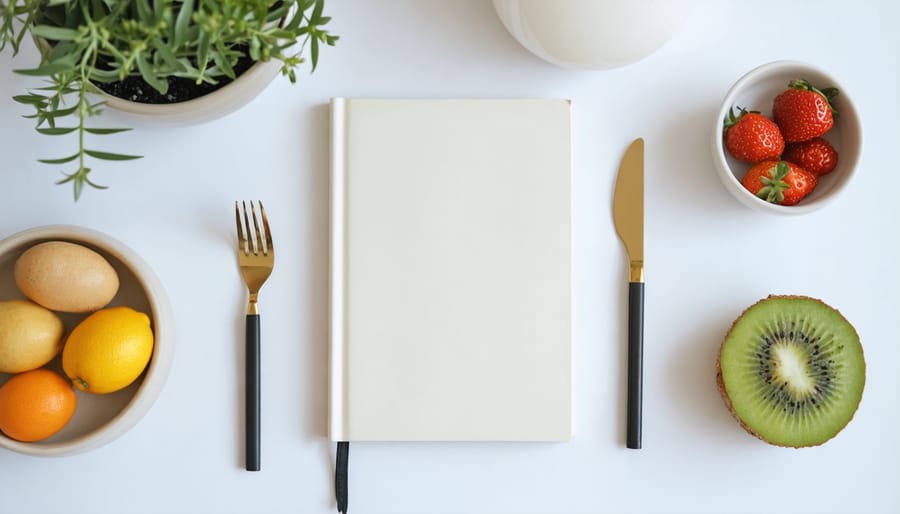
Transform your relationship with stress and mindful eating through this comprehensive, science-backed workbook designed for your modern lifestyle. Whether you’re struggling with emotional eating, mealtime anxiety, or simply seeking a more balanced approach to nutrition, this mindfulness-based stress reduction guide offers practical tools that seamlessly integrate into your daily routine.
Inside these pages, you’ll discover research-proven techniques that combine ancient mindfulness practices with contemporary psychology, specifically tailored for today’s fast-paced world. From bite-sized meditation exercises you can practice between meetings to intuitive eating protocols that help you reconnect with your body’s natural wisdom, each chapter builds upon the last to create lasting, sustainable change.
What sets this workbook apart is its highly personalized approach. Rather than presenting a one-size-fits-all solution, you’ll find customizable exercises, journaling prompts, and weekly action plans that adapt to your unique lifestyle and challenges. Through progressive chapters and hands-on activities, you’ll develop practical skills to navigate stress-induced eating patterns while fostering a more compassionate relationship with both food and self.
Ready to begin your journey toward mindful eating and stress reduction? Let’s explore these evidence-based strategies together, one conscious breath at a time.
Why Mindfulness Matters in Your Food Journey
The Stress-Eating Connection
Ever noticed how a stressful day at work can lead you straight to the cookie jar? You’re not alone. The connection between stress and eating habits is a powerful one that affects many of us, often without us even realizing it. When stress hormones surge through our bodies, they can trigger intense cravings for comfort foods – usually those high in sugar, salt, and fat.
Understanding this connection is the first step toward developing a healthier relationship with food. When we’re stressed, our bodies release cortisol, which can increase appetite and influence our food choices. It’s like our ancient survival mechanism kicking in, prompting us to stock up on high-calorie foods for perceived tough times ahead.
Think of your last stressful situation – did you reach for a salad or a slice of pizza? Most of us gravitate toward comfort foods because they temporarily boost our mood by releasing feel-good chemicals in our brains. However, this quick fix often leads to a cycle of emotional eating that can leave us feeling worse in the long run.
The good news is that awareness of this pattern is the first step toward positive change.
Your Brain on Mindful Eating
Ever noticed how a mindful bite of your favorite food feels completely different from rushing through lunch at your desk? That’s your brain on mindful eating! When we combine mindfulness with our eating habits, something remarkable happens in our bodies and minds.
Research shows that mindful eating activates our parasympathetic nervous system – our body’s natural “rest and digest” mode. This not only helps us better absorb nutrients but also reduces stress hormones like cortisol. I remember when I first started practicing mindful eating; the simple act of truly tasting my morning coffee transformed my entire day.
The benefits go beyond just digestion. Studies indicate that mindful eating helps strengthen the brain’s prefrontal cortex, improving our decision-making abilities around food choices. It also increases activity in areas associated with body awareness and emotional regulation, helping us better understand our true hunger and fullness cues.
By eating mindfully, we’re not just nourishing our bodies – we’re actually rewiring our brains for better health, reduced stress, and a more peaceful relationship with food. Think of it as a mini-meditation session with every meal!

Your Personal Mindful Eating Toolkit
Simple 5-Minute Mindful Eating Exercises
Let’s explore some quick mindful eating exercises that you can easily incorporate into your daily routine – even during your busiest days! I like to think of these as mini-moments of food awareness that can transform your relationship with eating.
Start with the “First Bite Practice”: Before taking your first bite, pause for just 30 seconds. Notice the colors, textures, and aromas of your food. Take a deep breath and express gratitude for your meal. This simple ritual helps set a mindful tone for your entire dining experience.
Try the “Put Down Your Fork” exercise: Between each bite, place your utensils on the table. This naturally slows down your eating pace and creates space for you to truly savor each mouthful. I was amazed at how different my favorite pasta dish tasted when I first tried this!
Practice the “5-4-3-2-1 Food Meditation”: Identify five things you can see on your plate, four textures you can feel, three sounds you hear while eating, two aromas you can smell, and one taste you’re experiencing. This exercise grounds you in the present moment and enhances your sensory awareness.
Remember, mindful eating isn’t about perfect practice – it’s about bringing gentle awareness to your meals, one bite at a time. Even implementing just one of these exercises can make a meaningful difference in your eating experience.
Creating Your Mindful Mealtime Ritual
Creating a mindful mealtime ritual can be a game-changer in your journey toward developing healthier mindful eating habits. Let’s break it down into simple, achievable steps that you can start implementing today.
Begin by choosing a dedicated space for your meals – somewhere calm and free from distractions. I love setting my table with a pretty placemat and using my favorite dishes, even when dining solo. It instantly signals to my brain that this is intentional, sacred time.
Next, take three deep breaths before starting your meal. Notice the colors, textures, and aromas of your food. What memories or feelings does this meal evoke? This brief pause helps transition your mind from the busy day to the present moment.
As you eat, try putting your utensils down between bites. Focus on chewing thoroughly and savoring each flavor. I found this challenging at first, but it’s become second nature with practice. Notice how different foods feel in your mouth and how your hunger signals change throughout the meal.
Keep your phone away and, if possible, eat without watching TV. Instead, use this time to connect with yourself or loved ones. Some of my most meaningful conversations happen during these mindful meals.
Remember, this isn’t about perfection – it’s about creating a peaceful, nurturing relationship with food and yourself. Start with one meal a day and gradually expand from there.

Stress-Relief Food Journal Templates
Journaling about your food experiences can be a powerful tool for stress relief and mindful eating. I’ve found that combining food journaling with emotional awareness creates a deeper understanding of our relationship with food. Let’s explore some templates that can help you on this journey.
Start with the Daily Food Mood Log, where you’ll record not just what you eat, but how you feel before, during, and after meals. This template includes spaces for noting your hunger levels, emotions, and any stress triggers that might influence your food choices. As someone who used to stress-eat during work deadlines, this practice helped me identify and reshape my patterns.
The Gratitude Food Journal template encourages you to write three things you appreciate about your meal or eating experience. This might include the nourishment it provides, the company you shared it with, or the memories it brings up. You can enhance this practice by using our comprehensive mindful eating worksheet alongside your journaling.
The Weekly Reflection Template helps you spot patterns in your eating habits and stress levels. Include sections for:
– Memorable meals and why they stood out
– Challenging food moments and how you handled them
– Food-related victories, no matter how small
– Goals for the coming week
Remember, these templates are flexible starting points. Feel free to modify them to better suit your personal journey toward mindful eating and stress reduction.
Mindful Recipe Makeovers

Breakfast with Presence
Start your day with intention by creating mindful moments during meals, beginning with your morning routine. Instead of rushing through breakfast while scrolling through your phone, try these nourishing practices that combine mindfulness with nutrition.
Start with a simple breathing exercise before your first bite. Take three deep breaths, expressing gratitude for the food before you. Choose breakfast foods that engage multiple senses – the warmth of oatmeal topped with colorful berries, the crunch of whole-grain toast with creamy avocado, or the aromatic comfort of herbal tea.
Try this mindful breakfast bowl: Combine Greek yogurt with honey, sprinkle with granola, and add fresh seasonal fruits. Before eating, take a moment to observe the colors, textures, and aromas. With each spoonful, notice the interplay of flavors and temperatures.
Practice eating without distractions for just five minutes. Notice how the food feels in your mouth, the subtle changes in taste as you chew, and your body’s signals of satisfaction. If your mind wanders, gently bring your attention back to the experience of eating.
Remember, mindful breakfast isn’t about perfect execution – it’s about creating a peaceful morning ritual that sets a positive tone for your day. Start small, perhaps with just one mindful bite, and gradually expand your practice.
Stress-Free Dinner Solutions
Transforming dinner from a source of stress into a mindful, rejuvenating experience starts with simple, intentional practices. As a busy mom who once dreaded the evening rush, I’ve discovered that the key lies in preparation and presence.
Start by creating a weekly meal plan that includes three easy-to-prepare dishes you can rotate. Keep ingredients for these reliable meals stocked, eliminating last-minute grocery store panic. My go-to is a sheet pan dinner with seasonal vegetables and protein – everything goes on one pan, leaving you free to practice deep breathing while it cooks.
Consider batch cooking on weekends when time feels more abundant. Prepare bases like quinoa or roasted vegetables that can transform into various meals throughout the week. This approach not only saves time but also reduces decision fatigue.
Make dinner prep a mindful ritual. Put on calming music, light a candle, and take three deep breaths before beginning. Focus on the sensory experience – the sound of chopping vegetables, the aroma of herbs, the colors on your cutting board. These simple moments become opportunities for presence.
For especially busy days, embrace the “assembly meal” concept: combine pre-prepared elements like rotisserie chicken, pre-cut vegetables, and wholesome grains. Remember, a stress-free dinner isn’t about perfection – it’s about nourishing yourself and your loved ones while maintaining inner peace.
Create a calm eating environment by clearing the table of non-meal items and turning off screens. This small act signals to your brain that it’s time to slow down and enjoy the present moment.
Weekly Progress Tracker
Celebrating Small Wins
In our journey toward mindful eating, it’s essential to recognize and celebrate even the smallest steps forward. Think of it like tending to a garden – every new shoot and leaf matters! Start by keeping a “wins journal” where you jot down daily victories, no matter how tiny they seem. Maybe you noticed yourself taking three deep breaths before lunch today, or perhaps you actually tasted the sweetness of your morning strawberries instead of rushing through breakfast.
Create a weekly ritual of reviewing your progress. Every Sunday evening, take five minutes to reflect on your mindful eating moments. Did you catch yourself before stress-eating? Did you enjoy a meal without scrolling through your phone? These are all wins worth celebrating!
Consider sharing your achievements with a friend or in our community forums. Sometimes, having someone else acknowledge our progress can make it feel more real and meaningful. Remember, transformation doesn’t happen overnight – it’s built on these small, daily victories that gradually become lasting habits. Each mindful bite, each moment of presence with your food, is a step toward a more balanced relationship with eating.
Adjusting Your Practice
Remember that your mindfulness journey is uniquely yours, and it’s perfectly okay to adjust your practice to better suit your needs. I’ve learned through my own experience that some days require gentler approaches than others. Start by paying attention to what works best for you during different times of the day or various emotional states.
If sitting meditation feels challenging, try walking mindfulness instead. Many of my clients find it easier to maintain focus while in motion. You might also experiment with the length of your sessions – sometimes a focused five-minute practice can be more beneficial than forcing yourself through twenty minutes when you’re feeling restless.
Don’t hesitate to modify the exercises in this workbook. If body scanning makes you uncomfortable, try starting with just one area, like your hands or feet. You can also incorporate mindfulness into daily activities you already enjoy, such as gardening or cooking. The key is to make these practices sustainable and enjoyable rather than another item on your to-do list.
Trust your intuition and be patient with yourself as you discover what resonates most deeply with your lifestyle and personality.
As we wrap up this mindfulness journey together, remember that transforming your relationship with food is a personal and ongoing process. The tools and techniques we’ve explored throughout this workbook are your stepping stones toward a more balanced, conscious approach to eating. Whether you’re just beginning to explore mindful eating or deepening your existing practice, every small step counts.
I’ve witnessed countless women discover newfound peace with food through these practices, and I believe you can too. Start with what feels most natural to you – perhaps it’s the simple breathing exercises before meals or keeping a gratitude journal about your food experiences. There’s no race to the finish line; this is your unique path to explore.
Remember, mindful eating isn’t about perfection. It’s about bringing awareness, compassion, and intention to your relationship with food. Some days will flow effortlessly, while others might challenge you – and that’s perfectly okay. The beauty lies in the practice itself, not the destination.
As you close this workbook, I encourage you to choose one practice that resonated most with you and commit to it for the next week. Notice how it feels, what changes you observe, and most importantly, be kind to yourself along the way. Your mindful eating journey is just beginning, and you’ve already taken the most important step by showing up for yourself.
Let’s continue supporting each other in this community as we grow and learn together. You’ve got this!



